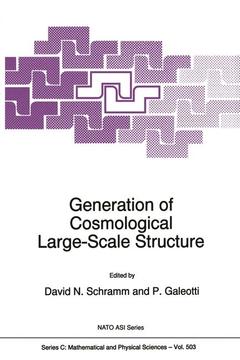Description
Generation of Cosmological Large-Scale Structure, 1997
Nato Science Series C: Series, Vol. 503
Coordinators: Schramm David N., Galeotti P.
Language: English
Subject for Generation of Cosmological Large-Scale Structure:
Keywords
Astronomical Observation; Cosmology; Dark matter; Redshift; Universe; astronomy; astrophysics
Publication date: 09-2011
317 p. · 16x24 cm · Paperback
317 p. · 16x24 cm · Paperback
Description
/li>Contents
/li>Comment
/li>
This volwne is the proceedings of the third school in particle astrophysics that Schramm and Galeotti have organized at Erice. The focus of thirs third school was the Generation of Cosmological Large-Scale Structure. It was held in November of 1996. The fIrst school in the series was on "Gauge Theory and the Early Universe" in May 1986, the second was on "Dark Matter in the Universe" in May 1988. All three schools have been successful under the auspices of the NATO Advanced Study Institute. This volume is thus the third in the series of the proceedings of these schools. The choice of the topic for this third school was natural, since the problem of generating a large-scale structure has become the most pressing problem in cosmology today. In particular, it is this generation of structure that is the interface between astronomical observations and particle models for the early universe. To date, all models for generating structures inevitably require new fundamental physics beyond the standard, SU x SU X U , model of high energy physics. The 3 2 I seeds for generating structures usually invoke unifIcation physics, and the matter needed to clump and form them seems to require particle properties that have not been seen in laboratories to date.
Preface; D.N. Schramm, P. Galeotti. List of Participants. Contributed Papers by Faculty. High Redshift Galaxies; G. Chincarini, P. Saracco. Dynamics of the Large-Scale Structure; S.F. Shandarin. The Large-Scale Structure of the Universe; A.S. Szalay. On Observing the Cosmic Microwave Background; L.A. Page. Introduction to Correlation Properties of Galaxy Distribution; L. Pietronero, et al. Dark Matter: An Introduction; D.N. Schramm. Ten Things Everyone Should Know About Inflation; M.S. Turner. Large-Scale Structure, Peculiar Velocities and the Density Field in the Local Universe; R. Giovanelli. Contributed Papers by Students. Higher Order Statistics from the EDSGC Catalog; I. Szapudi. On the Cosmological Mass Function; P. Monaco. A Few Points Concerning Galaxy Luminosity Functions; M. SubbaRao. Spectroscopy of Solar Neutrinos with BOREXINO; Th.P. Goldbrunner, M.E. Neff. Measuring Omega0 via the Bias Parameter; L. Verde, et al. A Two-Dimensional Percolation Analysis of the Las Campanas Redshift Survey; C. Yess. Minkowski Functionals in Cosmology: A Unifying Approach to Higher-Order Statistics of Large-Scale Structure; J. Schmalzing, M. Kerscher. A Wavelet Analysis of the Coma Cluster: Statistics and Morphology; M. Gambera, et al. Fluctuations in the IRAS 1.2 Jy Catalogue; M. Kerscher, J. Schmalzing. Testing Cosmological Models Using Damped Lyman-Alpha Absorbers; J.P. Gardner, et al. Evolution of the Two-Point Correlation Function: Zel'dovich Approximation vs. Scaling Ansätze; C. Porciani. The Substructure in Clusters of Galaxies; K. Berzins. Entropy Production in the Early universe: A New mechanism; P. DiBari. Pre-Big-Bang, Gravitons and Cosmology;M. Galluccio. The Implications of Luminosity Selection Effects in the Interpretation of the Angular Size-Redshift Data; A.A. Ubachukwu. Peaks Above the Harrison&endash;Zel'dovich Spectrum Due to the QCD Transition; P. Widerin, et al. The Cryogenic Dark Matter Search (CDMS); A. Sonnenschein, et al. Subject Index.
The generation of large-scale cosmological structures has become one of the most pressing problems in modern cosmology. This structure generation has become the interface between astronomical observations and particle models of the early universe. The seeds for the generation of structure usually involve unification physics, and the matter needed to clump and form the structures seems to require particle properties that have not been seen in laboratories to date. New astronomical observations seem to be discovering larger structures with high peculiar velocities, while observation of the microwave background anisotropy made with the COBE satellite, balloons, and ground-based experiments place tight constraints on possible primordial density fluctuation scenarios. The book deals with a ver
© 2024 LAVOISIER S.A.S.




